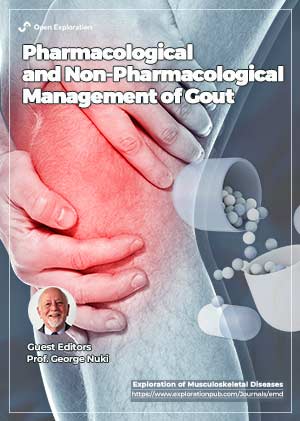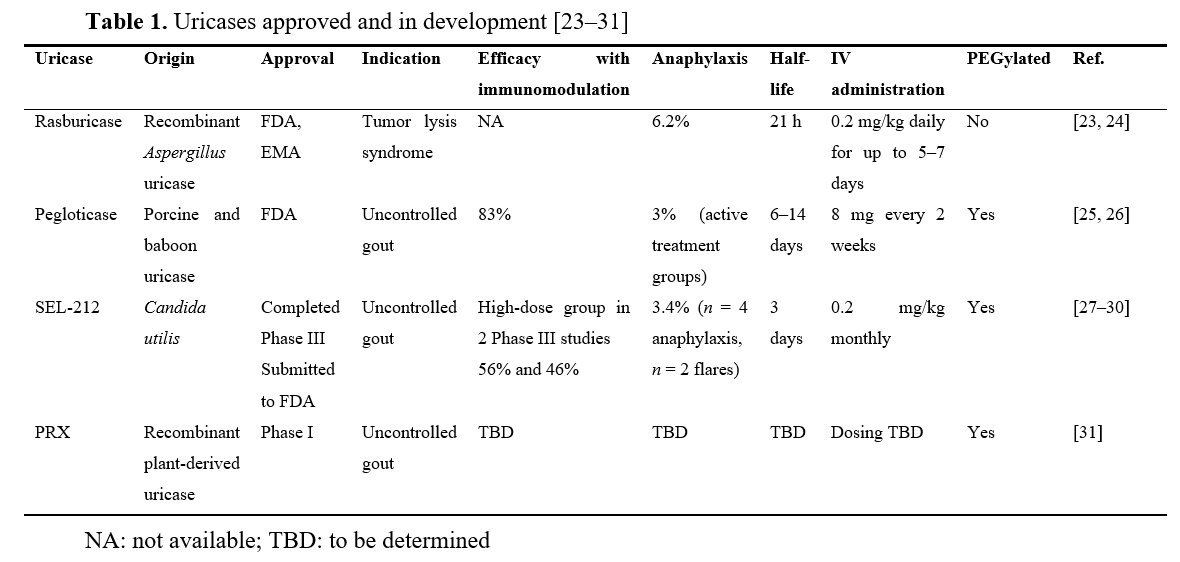-
 Special Issue Topic
Special Issue TopicPharmacological and Non-Pharmacological Management of Gout
Submission Deadline: January 31, 2025About the Special Issue
Although safe, effective, inexpensive, and potentially ‘curative’ urate-lowering drugs have been available for more than 50 years, there has been a global increase in the incidence of gout, and gout is now the most prevalent type of chronic inflammatory arthritis in Europe and North America. While there are numerous reasons why this eminently treatable disease has grown in incidence, prevalence and severity, it is clear that both the pharmacological and non-pharmacological management of gout remain suboptimal, despite the availability of national and international evidence-based treatment guidelines.
This special issue aims to bring together current research and some novel approaches to both the pharmacological and non- pharmacological management and prevention of gout flares, tophi, chronic gouty arthritis, and its renal, metabolic and cardiovascular co-morbidities.
Keywords: Gout, management, urate lowering therapy, uricosurics, xanthine oxidase inhibitors, uricase, nlrp3 inflammasome inhibitors, interleukin-1 antagonists, colchicine
Call for Papers
Published Articles
 How URAT1 inhibitors can shape the future of chronic gout treatment: a narrative review of uricosurics past and presentOpen AccessReviewGout is a common inflammatory arthritis preceded by chronically elevated levels of serum urate. In addition to leading to gouty flares, hyperuricemia can result in stone-like deposits of monosodium [...] Read more.Robert T. Keenan ... Michael H. PillingerPublished: December 12, 2024 Explor Musculoskeletal Dis. 2024;2:529–554
How URAT1 inhibitors can shape the future of chronic gout treatment: a narrative review of uricosurics past and presentOpen AccessReviewGout is a common inflammatory arthritis preceded by chronically elevated levels of serum urate. In addition to leading to gouty flares, hyperuricemia can result in stone-like deposits of monosodium [...] Read more.Robert T. Keenan ... Michael H. PillingerPublished: December 12, 2024 Explor Musculoskeletal Dis. 2024;2:529–554
DOI: https://doi.org/10.37349/emd.2024.00077 Should all people starting urate-lowering therapy for gout receive anti-inflammatory prophylaxis?Open AccessCommentaryCo-prescription of anti-inflammatory prophylaxis with colchicine, non-steroidal anti-inflammatory drugs (NSAIDs), or corticosteroids when initiating urate-lowering therapy (ULT) for gout is recommen [...] Read more.Edward Roddy ... Christian D. MallenPublished: November 15, 2024 Explor Musculoskeletal Dis. 2024;2:521–528
Should all people starting urate-lowering therapy for gout receive anti-inflammatory prophylaxis?Open AccessCommentaryCo-prescription of anti-inflammatory prophylaxis with colchicine, non-steroidal anti-inflammatory drugs (NSAIDs), or corticosteroids when initiating urate-lowering therapy (ULT) for gout is recommen [...] Read more.Edward Roddy ... Christian D. MallenPublished: November 15, 2024 Explor Musculoskeletal Dis. 2024;2:521–528
DOI: https://doi.org/10.37349/emd.2024.00076 Evaluation of continued 2-monthly or annual urate monitoring in gout: an extension of the GoutSMART randomised controlled feasibility trialOpen AccessOriginal ArticleAim: Improved outcomes for patients with gout are associated with reduced urate levels and many guidelines recommend regular urate monitoring. There is no consensus on how frequently monitoring s [...] Read more.Philip L. Riches ... Amrey KrausePublished: November 11, 2024 Explor Musculoskeletal Dis. 2024;2:509–520
Evaluation of continued 2-monthly or annual urate monitoring in gout: an extension of the GoutSMART randomised controlled feasibility trialOpen AccessOriginal ArticleAim: Improved outcomes for patients with gout are associated with reduced urate levels and many guidelines recommend regular urate monitoring. There is no consensus on how frequently monitoring s [...] Read more.Philip L. Riches ... Amrey KrausePublished: November 11, 2024 Explor Musculoskeletal Dis. 2024;2:509–520
DOI: https://doi.org/10.37349/emd.2024.00075 Addressing weight loss management in obese gout patients: guidance for future trialsOpen AccessCommentaryObesity is widely recognized as being associated with both the onset and advancement of gout, exerting a detrimental effect on health outcomes in society. In the realm of gout management, theoretica [...] Read more.Robin Christensen ... Lisa K. StampPublished: November 07, 2024 Explor Musculoskeletal Dis. 2024;2:498–508
Addressing weight loss management in obese gout patients: guidance for future trialsOpen AccessCommentaryObesity is widely recognized as being associated with both the onset and advancement of gout, exerting a detrimental effect on health outcomes in society. In the realm of gout management, theoretica [...] Read more.Robin Christensen ... Lisa K. StampPublished: November 07, 2024 Explor Musculoskeletal Dis. 2024;2:498–508
DOI: https://doi.org/10.37349/emd.2024.00074 Bridging the evidence-practice gap for people with goutOpen AccessCommentaryGout is a common and disabling form of arthritis. Despite widely available, highly effective, urate-lowering therapies, such as allopurinol, studies continue to demonstrate poor care for individuals [...] Read more.Mark D. Russell, James B. GallowayPublished: October 23, 2024 Explor Musculoskeletal Dis. 2024;2:473–477
Bridging the evidence-practice gap for people with goutOpen AccessCommentaryGout is a common and disabling form of arthritis. Despite widely available, highly effective, urate-lowering therapies, such as allopurinol, studies continue to demonstrate poor care for individuals [...] Read more.Mark D. Russell, James B. GallowayPublished: October 23, 2024 Explor Musculoskeletal Dis. 2024;2:473–477
DOI: https://doi.org/10.37349/emd.2024.00071 Uricases: reflections on recent developments in the management of challenging gout patientsOpen AccessReviewOral urate-lowering therapy (ULT) is key to treating gout. However, many patients receiving oral ULT do not achieve the target serum urate (SU) levels, partly because some patients cannot tolerate o [...] Read more.Naomi Schlesinger, Dan KaufmannPublished: October 02, 2024 Explor Musculoskeletal Dis. 2024;2:461–472
Uricases: reflections on recent developments in the management of challenging gout patientsOpen AccessReviewOral urate-lowering therapy (ULT) is key to treating gout. However, many patients receiving oral ULT do not achieve the target serum urate (SU) levels, partly because some patients cannot tolerate o [...] Read more.Naomi Schlesinger, Dan KaufmannPublished: October 02, 2024 Explor Musculoskeletal Dis. 2024;2:461–472
DOI: https://doi.org/10.37349/emd.2024.00070 Safety and efficacy of gout treatments in people with renal impairmentOpen AccessReviewGout is common in people with chronic kidney disease and in general is sub-optimally managed. Lack of evidence due to the exclusion of people with chronic kidney disease from the majority of clinica [...] Read more.Hamish Farquhar ... Lisa K. StampPublished: September 02, 2024 Explor Musculoskeletal Dis. 2024;2:360–374
Safety and efficacy of gout treatments in people with renal impairmentOpen AccessReviewGout is common in people with chronic kidney disease and in general is sub-optimally managed. Lack of evidence due to the exclusion of people with chronic kidney disease from the majority of clinica [...] Read more.Hamish Farquhar ... Lisa K. StampPublished: September 02, 2024 Explor Musculoskeletal Dis. 2024;2:360–374
DOI: https://doi.org/10.37349/emd.2024.00062 -
-
Ongoing Special Issues
-
Completed Special Issues